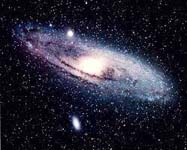
| Bad Astronomy |
|
|
|
BA Blog
|
|
Q & BA
|
|
Bulletin Board
|
| Media |
|
|
|
Bitesize Astronomy
|
|
Bad Astro Store
|
|
Mad Science
|
|
Fun Stuff
|
| Site Info |
|
|
|
Links
|
| RELATED SITES |
| - Universe Today |
| - APOD |
| - The Nine Planets |
| - Mystery Investigators |
| - Slacker Astronomy |
| - Skepticality |
Buy My Stuff

Keep Bad Astronomy close to your heart, and help make me
filthy rich. Hey, it's either this or one of those really
irritating PayPal donation buttons here.
How Far can you See?
Week of February 3, 1997What's the farthest distance you can see? Looking around during the day, chances are the farthest you can see is only a few kilometers. If you are up in a tall building, you might be able to see objects as much as 100 kilometers away. In an airplane, that distance might double or triple.
But if you look up, you can see for about 150 million kilometers! That's how far away the Sun is. If you wait a few hours for nightfall, you'll see a lot farther. Saturn, the farthest planet from the Earth easily visible to the unaided eye, is about a billion kilometers away on average. But even that is closeby compared to the stars. The nearest star is 4 light years, or 40 trillion kilometers away. Betelgeuse, the bright red star that marks Orion's shoulder, is about 400 light years, or 4 quadrillion kilometers away (that's a 4 followed by 15 zeroes!).
 But even that is small change. The Andromeda Galaxy, a
collection of billions of stars much like our own Milky Way Galaxy,
is not hard to see with the naked eye from a dark spot
on a winter night, and it is 2.9 million light years away.
That's about 20 million million million kilometers away,
or a 2 followed by 19 zeroes!
But even that is small change. The Andromeda Galaxy, a
collection of billions of stars much like our own Milky Way Galaxy,
is not hard to see with the naked eye from a dark spot
on a winter night, and it is 2.9 million light years away.
That's about 20 million million million kilometers away,
or a 2 followed by 19 zeroes!
So on a clear day, you can see quite a ways, but on a clear night, you almost can see forever.
The Students for the Exploration and Development of Space (SEDS) group has an excellent page with a thorough description of the Andromeda galaxy . It also has links to more info about one of our nearest spiral neighbors.
Thanks to Bitesize Reader Troy Hoffman for pointing out I had written `miles' at one point on this page instead of `kilometers'. Also, thanks to regular Bad Reader Russ Bogel for pointing out that I had an old distance to the Andromeda Galaxy listed. The new distance of 2.9 million light years came out after the Hipparcos satellite made better distance measurements to nearby stars.
|
|
| THE PANTRY: ARCHIVE OF BITESIZE SNACKS |
|
|
| Subscribe to the Bad Astronomy Newsletter! |
| Talk about Bad Astronomy on the BA Bulletin Board! |